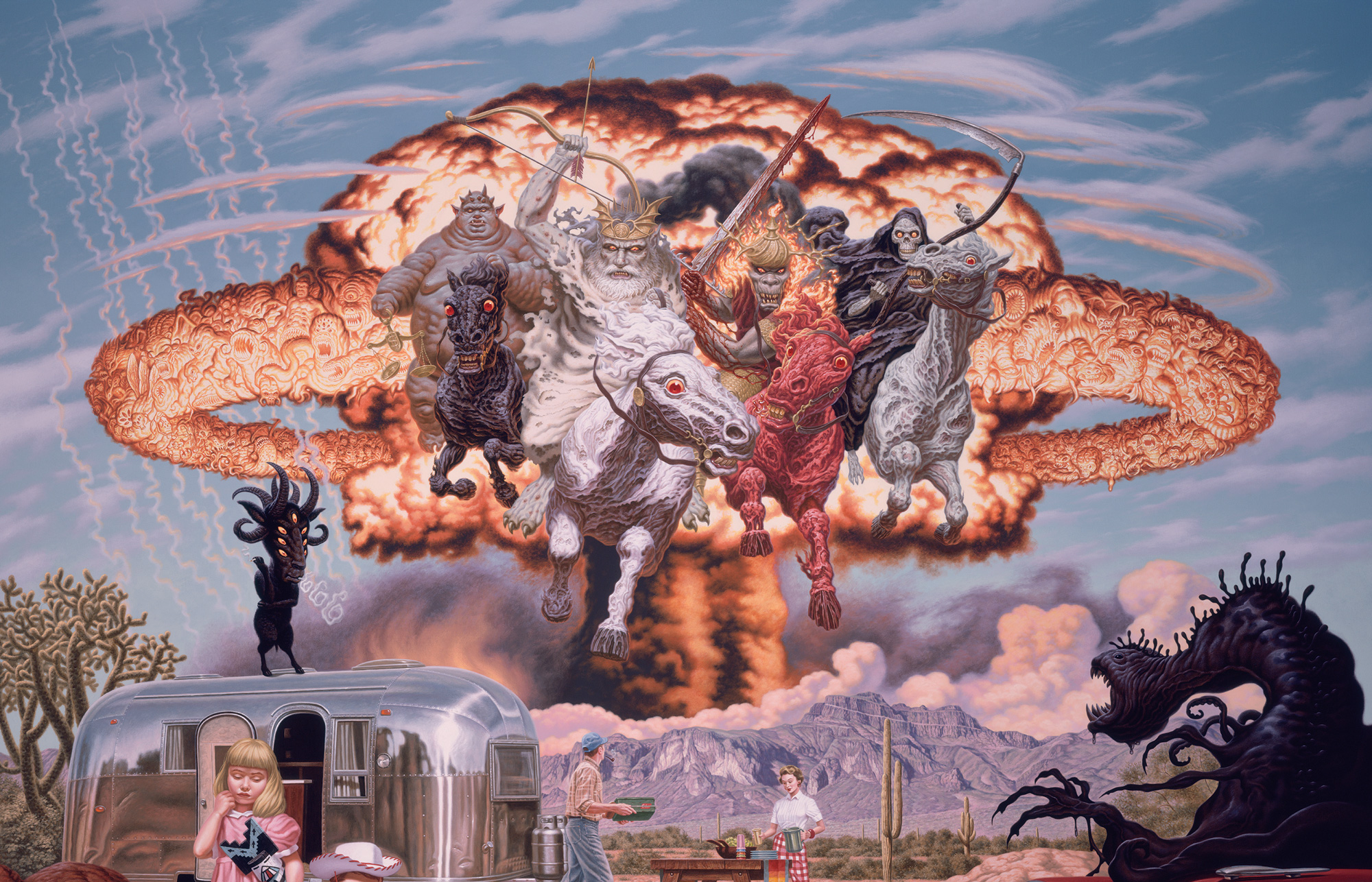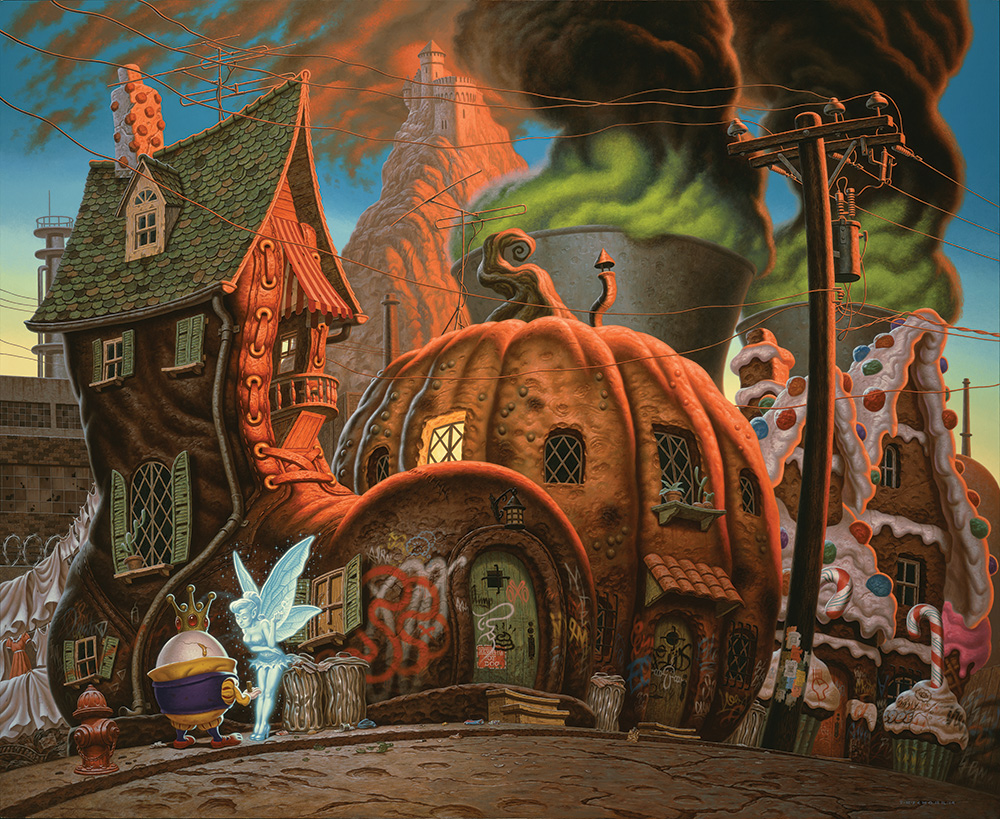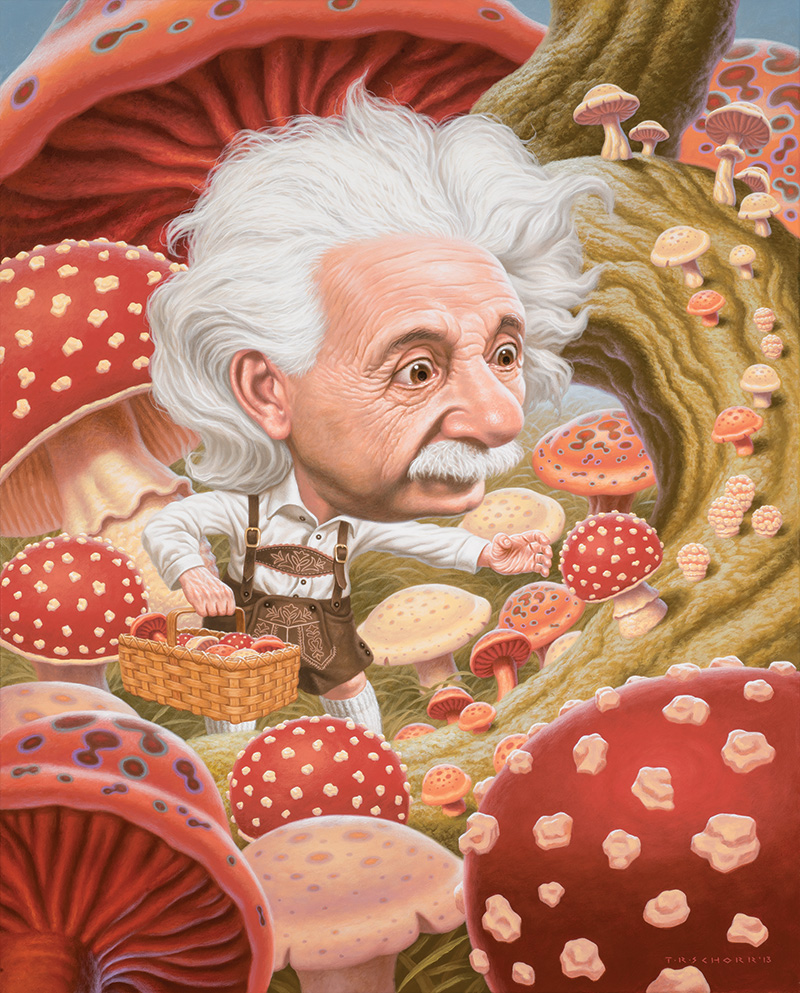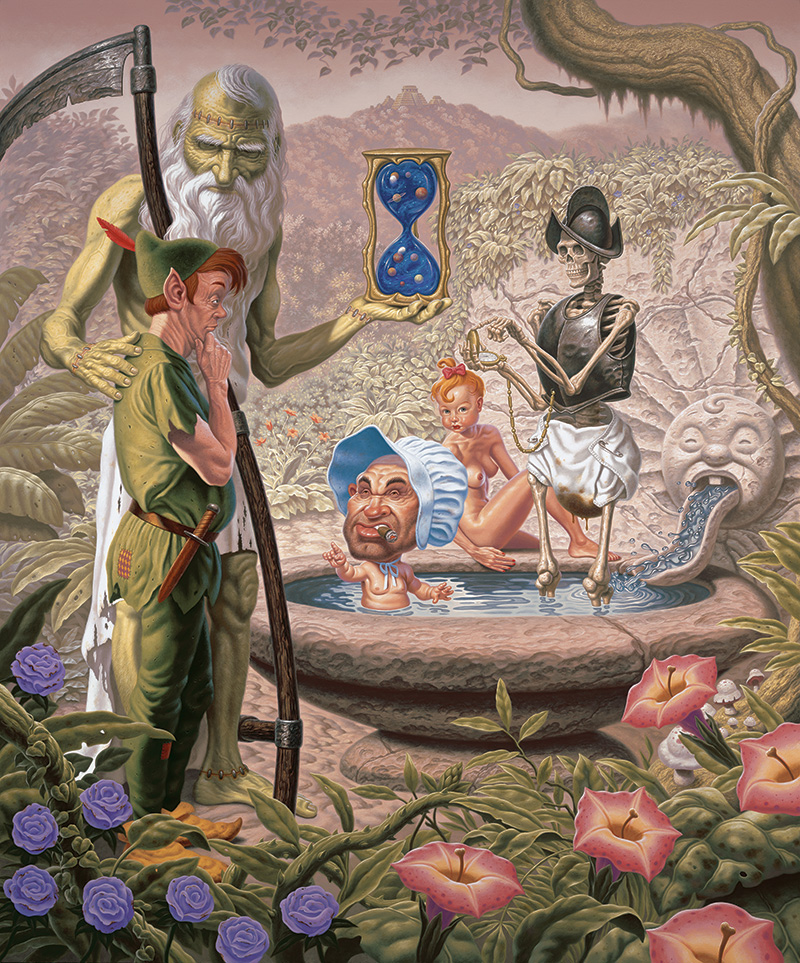
Todd Schorr
An American Surrealist
Interview by Gregg Gibbs
There may not be a more dedicated and industrious artist than Todd Schorr. His work ethic is legendary, his output exemplified by dogged attention to detail and skill in technique. Such a notable career, when taken in sum, encapsulates a unique, personal vision of a conjured world in which he establishes surreal appeal by creating phantasmagorical images that mesmerize the viewer in their meticulously painted execution. Although the label “lowbrow” may be shunned by other artists of his generation, Schorr actually validates the colloquial term and summarizes the genre’s basic traits. In other words, he takes what are often considered to be low cultural references and elevates them into significant artifacts that pulsate with intellectual viability.
This year features two high-profile projects that represent an overview of the artist’s extensive oeuvre. One is a weighty, comprehensive catalogue that pulls together 30 years of work, highlighting an ongoing fascination with a world in constant evolution and transition. The book is packed with paintings that represent a combination of an abstracted cartoon vocabulary channeled through the techniques of the old masters. The other is a museum-sized exhibition that will commence on the East Coast with plans to travel to other destinations. It’s an event with broad appeal that is sure to break attendance records due to its profound, enticing, and enlightening visuals.
I’ve been a bona fide fan since first encountering Todd’s paintings many years ago and had the pleasure of getting to know him while documenting his work process for my film, The Treasures of Long Gone John. So, it was a thrill to catch up with him recently as he chatted with me from his studio in Connecticut.

Gregg Gibbs: Tell me about this new retrospective exhibition at MOCA Virginia and the show’s focus on your autobiographical work. How do you incorporate certain aspects of your life experience into your paintings?
Todd Schorr: The curators wanted to focus on works they felt were autobiographical in some way. This may appear in paintings based on early visual influences, such as cartoons, monster movies, comic books, etc., or in works like “The Amphibian Frontier” and “Lessons in Ballyhoo” which are based on lived experiences.
The title of the show, Atomic Vacation, is derived from one of the major paintings included in the show. What’s the narrative of this seminal work and how did it become the title of the retrospective?
Atomic Vacation is my reflection on living in the era of “duck and cover drills” and the general nuclear anxiety of my early childhood years in the late ’50’s early ’60s. It was also around this time that our family summer vacations took the form of camping trips. There was always news coverage on TV about the latest bomb tests and, of course, the culmination of cold war paranoia with the missile crisis in Cuba. To this day, I have recurring dreams where I’m out in some vast expanse of landscape when an enormous mushroom cloud looms up on the horizon. The real horror of this scenario is that the sound wave has not yet hit, so it’s just this enormous radioactive cloud, and in my painting, I’ve added the Four Horsemen of the Apocalypse, charging ahead of the blast as an added bit of drama.
Is there a common thread that unites the themes in your paintings? How does each work relate to the other?
I’m really all over the place with themes as I’m into so many different things at any given time. However, I do come back to subjects that I have a special fascination with, like human evolution and how it relates to all our many varied behaviors and obsessions.

You have a new monograph called Neverlasting Miracles, which is also the title of one of the paintings in the show. What was your approach to putting together this comprehensive compilation of your work?
The new book is an edited overview of just about all the paintings I’ve done over the last 30 years, so it’s basically a chronological survey of the work as well as a biographical timeline.
You seem to have an extensive knowledge and interest in paleontology, but you often add your own twist to the science. A good example is The Hidden Neanderthal. What do you intend to convey to the viewer with such elaborate visual language?
I was interested in the latest scientific evidence that the Neanderthal genome has been found in the DNA of many modern-day humans. The Neanderthal became absorbed but not entirely extinct, and this painting addresses that long ago romance. This, along with the fact that we are all products of millions of years worth of social interaction with many different ethnic varieties, led to the concept for this painting. Our genetic lottery. The Jack in the Box clown holding the baby rattle surrounded by an infinite swirl of lottery balls adds a comic touch.
I’ve always been fascinated by the narratives behind your major paintings because there is so much going on. How do you begin to formulate these complex compositions?
Occasionally, I’ll have a pretty clearly formed idea at the moment of inspiration. But, for the most part, the concepts come from an assortment of notions of ideas that I’ll jot down in a sketchbook. Sometimes they come together to form what could be an interesting composition and sometimes they can languish around for years until some other creative spark pulls them together. Obviously the key to coming up with interesting work is making sure your imagination remains rich, evolving, and thriving. I love Einstein’s quote, “Imagination is more important than knowledge.”

Does the little boy in Lessons in Ballyhoo represent you and your interest in carnival imagery? How does Americana figure into your concepts?
The Ballyhoo painting is based on a childhood experience. When I was about four or five years old, my parents took me to the Ringling Brothers, Barnum and Bailey Circus that was set up at the old Madison Square Garden in NYC. I remember loving the actual three-ring circus with the clowns, animals, etc. But on the way in, you had to pass through the midway, which was set up outside the main arena. Being led by my parents through the hot press of sweaty bodies as the screaming carny barkers made their pitch into microphones surrounded by all manner of questionable attractions, I’m sure I was on the verge of passing out. How often is it the things that most frightened you as a child become the things you love as an adult?
Which do you rely on more, your imagination or reference material?
The imagination kicks it off and then, depending on the amount or accuracy of detail needed for the subject matter, I’ll bring in reference. If the painting is mainly abstract cartoon in nature, I can work totally from imagination.
With the completion of this new retrospective and book, what are your plans for the future?
I’m currently working on two very large paintings that are related with one another in an odd way. I was hoping to include at least one of them in the upcoming show but they are just too involved to finish by then. I’ll debut them at a later date in the upcoming future.
Todd Schorr’s Atomic Picnic at The Museum of Contemporary Art, Virginia opens September 21 and will run until December 30, 2018





